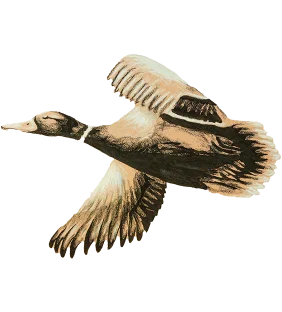Mallard
The Mallard duck (Anas platyrhynchos) is included in the subfamily of, diving and swimming ducks. Mallard is the most important hunting species of waterfowl. It inhabits Europe, a large part of Asia, and North America.
They are mostly migratory birds in Eastern and Northern Europe and migrate from October to Central, Western, or Southern Europe. In southern and western Europe, on the contrary, they generally do not have a migratory behaviour, but they are fixed in place. In Central Europe, they can stay put and take short or long trips.
In our country, mallard duck is widespread throughout the territory; it is most abundant in the West Slovak and East Slovak Lowlands. The number of breeding pairs is estimated at approximately 12,000-20,000, while the number of wintering individuals is up to 60,000-120,000.
The total length of the duck's body is 50-60 cm, the wingspan is up to 95 cm, weight is 0.8-1.5 kg. The males are considerably larger.
A male is significantly different from a female by the colouring of its feathers. The female has inconspicuous brown feathers and a yellow-brown beak. The male is brightly coloured. It has shiny dark green feathers on its head and neck and a yellow-green beak. It has a white ring around its neck and its chest, back and wings are maroon. Both the female and the male have a blue mirror on their wings.
The mallard nests on the banks of streams, rivers, lakes, or marshes with denser vegetation The duck is mainly herbivorous. She likes seeds, fruits, and green aquatic and coastal plants. Forages on or just below the surface in shallow water; the rest of the food consists of insects, molluscs, crustaceans, and other invertebrates.
The mating season is in the spring. A duck usually lays 10 to 12 eggs. Females sit on eggs once a year for 25 to 28 days. Ducklings hatch very well-developed, leave the nest after a short time, and can swim from the start. In the first hours of life, they run after whoever they see first. This is most often the mother, who takes them to the water shortly after hatching. In species of animals that care for young, this form of interaction of learning and innate behaviour is a very important part of the reproductive cycle. The duck looks after the young for 50 to 60 days, after which time they can fly.
Mallards are mostly hunted during the morning or evening migration. A hunting dog is also used in such a hunt, which reliably searches for and brings a shot piece. Another way of hunting is luring by planting an artificial duck or imitating a duck call with a decoy.
Joint hunts are organized mainly on larger bodies of water.in pheasant houses, where the charm of the "wild" pheasant is lost.

